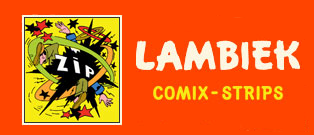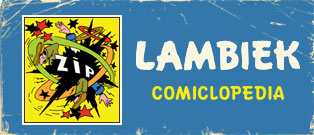Comic strip of 'A Kockásfülű Nyúl', published in the Tükör newspaper (1975).
Zsolt Richly was an award-winning Hungarian cartoon director, animator and graphic artist, with longtime associations with the Pannónia Film Studio and the Kecskemét Studio. In animation, he was best-known for directing animated shorts and TV series based on Hungarian folklore and music. Together with Veronika Marék, he was responsible for the animated children's show 'A Kockásfülű Nyúl' ("The Rabbit with Checkered Aars", 1977-1979), and was also the artist of the comic strips related to the series.
Early life
Zsolt Richly was born in 1941 in Sopron, a Hungarian city near the Austrian border. Showing early creative talent, he spent his school days doodling during lessons. In 1959, the eighteen-year old sent a letter to Walt Disney in the United States, along with some of his drawings. Much to his surprise, he received a reply, along with the guidebook 'The Art of Animation' as a stimulus for his cartooning ambitions.
After attending the local Berzsenyi Dániel Evangelical Lyceum, Richly went to Budapest in 1962 to enroll at the department for decorative painting of the Hungarian Academy of Arts and Design. In 1966, Richly graduated as a member of the school's newly launched animation department, with the short 'In India' as his thesis. This first excursion into the field of animation had much success at film festivals.
'Gyurma Gyuri' (Kisdobos, 1962).
Comics
While still a student, Richly additionally worked as an illustrator and comic artist for youth newspapers and magazines, an activity he continued at times during his later animation career. Between 1962 and 1966, he drew a largely pantomime comic feature called 'Gyurma Gyuri' for Kisdobos, the children's magazine of the Association of Hungarian Pioneers. The main character was a toy made from plasticine by a little girl. Later in the series, additional characters were added, such as Gyurma Kati (a plasticine girl) and Gyurma Csiga (a plasticine snail). Returning to the magazine in the 1970s, Richly created the feature 'Négyszem' (1971-1978), literally meaning "Four Eyes", about a little girl with glasses. In the final episodes, printed in 1977 and 1978, the character appeared without glasses and was for the occasion renamed to 'Csupaszem', meaning "Bare Eye".
Still from the 'Fabulák' TV series (1980s).
Pannónia Film Studio
After graduation in 1966, Richly found employment with the largest animation studio in Hungary, the Pannónia Film Studio. Working under the guidance of master cartoon director Gyula Macskássy, his first job was painting backgrounds for the 'Peti' series. For over 25 years, Richly remained with Pannonia as writer, animator and director, participating in the production of a great many TV series, feature films and children's productions.
During his career, Richly particularly stood out for his experimentation with color and his usage of folklore, classical music and popular culture as themes for his animated films. An important inspiration for his work was the composer Zoltán Kodály (1882-1967), who embraced folkloric motifs in his music. One of Richly's first productions was the 1968 film 'Szvit' ('Suite'), based on five Hungarian folk songs turned into a musical play by Kodály. Further films were 'Anna Molnár' (1972), for which he experimented with a palette of four colors, his adaptation of 'The Goat and the Ram' ('A Kecske és a Kos', 1974) and his feature-length film 'János Háry' (1983) - also based on a musical comedy by Zoltán Kodály.
During the 1980s, Richly also served as director for animated TV series based on fairy tales, such as 'Fabulák' (1988-1989), with the fairy tale stories of Gáspár Heltai, and 'Kíváncsi Fáncsi' ("Curious Fáncsi", 1984-1989), based on the book series by Miklós Ákos Tordon.
One of the slides from 'Harcsabajusz Kapitány' (1978).
Slides
In addition to comics and films, Zsolt Richly drew and produced slideshows for wall projectors, again with strong connections to folklore and fairy tales. Among his most successful were 'Harcsabajusz Kapitány' ("Captain Catfish Mustache", 1978), 'The Little Rooster's Diamond Halfpenny' ('A kiskakas gyémánt félkrajcárja', 1981) and 'Mattie the Goose-boy' ('Matyi Lúdas', 1988).
The Rabbit with Checkered Ears
While working for Kisdobos magazine in the 1970s, Richly first met fellow graphic artist Veronika Marék, with whom he began a collaboration for new animation projects for the Pannónia Film Studio. Marék as writer, Richly as animator and director. After the 1973 short film 'A Hétpöttyös Autó' ('The Seven-Dot Car'), they co-created a new character, 'A Kockásfülű Nyúl' ("The Rabbit with Checkered Ears"). Prior to the release of the TV series, the character first appeared in a series of newspaper strips written by Marék and drawn by Richly for the newspaper Tükör (1975). The subsequent 26-episode animated children's TV series (1977-1979) ran every Saturday on the Hungarian TV channel Magyar Televízió.
In these short pantomime films, a rabbit with big ears awakes every morning from a suitcase in the attic of a large apartment building. From the rooftop, he uses his binoculars to spot if someone needs his help, and then uses his ears as propellers to fly to the aid of one of the four main children characters. Prior to the TV show, the big-eared bunny appeared in a 1975 comic strip in the Tükör newspaper.
After its initial syndication in Hungary and its surrounding countries, the series appeared in about 90 other countries around the work, including the USA, where it ran on the 'Pinwheel' cable program on Nickelodeon. In later years, the rabbit character has become a cult icon of Hungarian animation, often described by U.S. fans as "bunny in a suitcase". It has appeared as plush toy and on merchandise items as school accessories and pillows. Twelve new episodes were released in 1996, directed by Gábor Fischer and Vanda Arányi, and an additional one in 2018, created by Veronika Marék and director Barbara Bakos.
In 2002 and 2003, two DVD sets of the series were released. Comics with the character appeared in the short-lived children's magazine Padlás (1999), and later in three comic books with speech balloons (2007-2008), written by Veronika Marék and illustrated by Zsolt Richly.
Later career in animation
Starting in 1987, Zsolt Richly became a teacher in animation at the Hungarian University of Arts and Design (since 2008 known as the Moholy-Nagy University of Art and Design), where he trained an entire new generation of Hungarian animators. After the collapse of the Pannónia Film Studio, Richly began an association with the Kecskemét Studio. Starting in 2003, he directed a total of eight short films for them, including 'Árgyélus királyfi' ("Prince Árjélus", 2003), 'A Hetvenkedő Sün' ("The Seventy-Year-Old Hedgehog", 2004), 'A Kevély Kiskakas' ("The Arrogant Little Rooster", 2006) and 'Kőműves Kelemen' ("Stonemason Kelemen", 2009). His final work was a series titled 'The Life of Martin Luther' (2016), made on request from the Evangelical church, with a script by János Lackfi. In 2019, a four-episode comic book based on this movie was published, written and drawn by Kata Major.
Recognition
One of Hungary's most prominent directors of animated films, Zsolt Richly was awarded on several occasions. In 1981, he received the Balázs Béla Award. Later, he was named "Merited Artist of the Hungarian Peoples Republic" (1986) and "Excellent Artist of the Hungarian Peoples Republic" (2014). In 2007, Richly was in the international jury of the Kecskemét Animation Film Festival. At the festival of 2017, an exhibition with still images from his 'Luther' series was organized.
Death
Zsolt Richly died in 2020 at the age of 78. In the obituary on the site of the Kecskemét Studio, he was honored as "the first Hungarian director who broke away from the Disney traditions."








